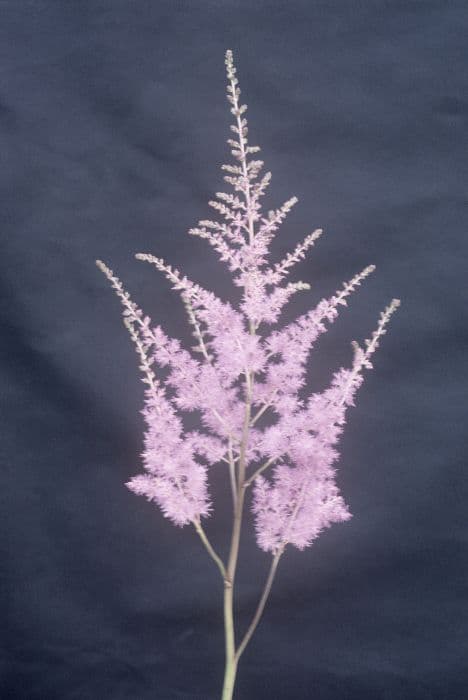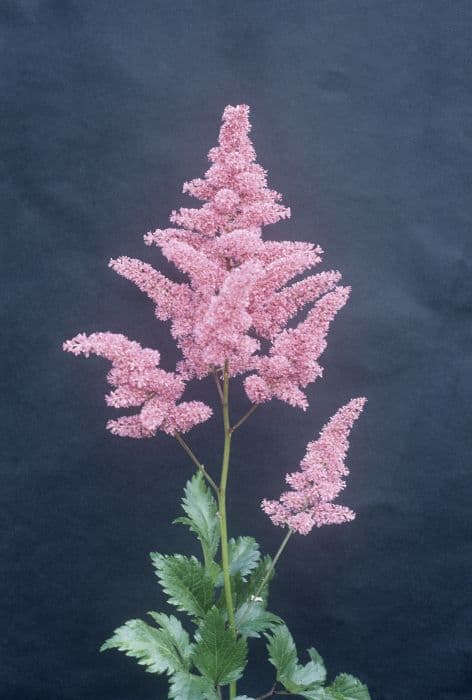Coral Bells Heuchera 'Rachel'

ABOUT
Heuchera 'Rachel' is a captivating perennial known for its vibrant foliage and dainty flowers. The leaves of 'Rachel' are truly striking, typically showing off a rich tapestry of colors ranging from deep purples to silvery greens, often with intricate veining that may be darker or lighter than the leaf itself. The texture of the leaves can be described as somewhat ruffled or curled, adding to the visual interest of the plant. In contrast to the bold leaves, the flowers of Heuchera 'Rachel' are delicate and small. They appear on slender, erect stems that rise above the foliage, creating a lovely airy feeling. The blossoms are usually bell-shaped and can come in shades that complement the leaves, like soft pinks or whites. The overall impression of Heuchera 'Rachel' is one of a robust and ornamental clump that provides a burst of color and texture to any garden setting. It is particularly prized for its year-round visual appeal, as the foliage often maintains its color through multiple seasons, and the plant can provide groundcover interest even when not in bloom.
About this plant
 Names
NamesFamily
Saxifragaceae
Synonyms
Coral Bells, Alumroot
Common names
Heuchera 'Rachel'
 Characteristics
CharacteristicsLife cycle
Perennials
Foliage type
Semi-deciduous
Color of leaves
Mixed
Flower color
White
Height
1-2 feet (30-60 cm)
Spread
1-2 feet (30-60 cm)
Plant type
Herb
Hardiness zones
4-9
Native area
North America
Benefits
 General Benefits
General Benefits- Ornamental appeal: Heuchera 'Rachel' offers a year-round visual interest with its attractive foliage and delicate blossoms.
- Low maintenance: It doesn't require much care once established, making it suitable for gardeners of all levels.
- Drought tolerance: After establishing, it can tolerate periods of low water, reducing the need for constant watering.
- Pest and disease resistance: Generally resistant to common garden pests and diseases, decreasing the need for chemical treatments.
- Attracts pollinators: The flowers can attract butterflies and bees, promoting a healthy ecosystem in your garden.
- Versatile in landscaping: Can be used in borders, as groundcover, or in container gardens, offering diverse design possibilities.
- Seasonal interest: Provides a range of colors and textures throughout the seasons, including fall when many other plants have lost their luster.
 Medical Properties
Medical PropertiesThis plant is not used for medical purposes.
 Air-purifying Qualities
Air-purifying QualitiesThis plant is not specifically known for air purifying qualities.
 Other Uses
Other Uses- Edging for pathways: Heuchera 'Rachel', commonly known as coral bells, can be planted along pathways as a visually appealing edge, providing a contrasting texture to the pavement.
- Seasonal crafts: The leaves of coral bells, with their unique coloration, can be used in fall crafts, making decorative wreaths and other autumn-themed ornaments.
- Natural dye: The colorful leaves of the coral bells may be used to create natural dyes for fabrics or paper, giving them an earthy tone.
- Photography subject: Due to their unique foliage, coral bells can be excellent subjects for macro and nature photography, adding diversity to botanical portfolios.
- Leaf casting: The textured leaves of coral bells can be used in concrete or plaster casting projects to create garden ornaments or stepping stones with leaf patterns.
- Culinary garnish: While not commonly used for this purpose, the flowers of coral bells can be a decorative edible garnish for salads or desserts.
- Fairy gardens: The small stature and enchanting appearance of coral bells make them ideal for including in fairy gardens or other miniature garden designs.
- Livestock feed: In some cases, the leaves of coral bells could be used as a minor food source for livestock, such as rabbits or goats, when other feeds are scarce.
- Education: Coral bells can be used to educate students and garden enthusiasts about plant propagation and hybridization due to their wide variety of cultivars and ease of propagation.
- Soil erosion control: When planted in groups, coral bells aid in soil stabilization due to their clumping growth habit, helping to prevent erosion in garden areas.
Interesting Facts
 Feng Shui
Feng ShuiThe plant Heuchera, commonly known as Coral Bells, is not explicitly used in Feng Shui practice.
 Zodiac Sign Compitability
Zodiac Sign CompitabilityCoral Bells is not used in astrology practice.
 Plant Symbolism
Plant Symbolism- Enduring Beauty: Heuchera, commonly known as Coral Bells, are valued for their year-round foliage, symbolizing enduring and persistent beauty in landscape design.
- Variety and Versatility: With diverse leaf colors and textures, Coral Bells represent versatility and adaptability in various conditions and garden styles.
- Balance and Contrast: Often used to provide contrast in gardens, Coral Bells can symbolize the importance of balance and diversity in our lives.
- Attraction and Allure: The dainty bell-shaped flowers of the Heuchera attract hummingbirds and butterflies, symbolizing allure and the capacity to draw in positivity and interest.
 Water
WaterCoral Bells should be watered deeply once a week, allowing the soil to dry out slightly between waterings. It's best to water these plants in the morning to reduce evaporation and give the foliage time to dry out, which helps prevent disease. Aim to provide about one inch of water, which equals roughly 0.6 gallons, each time you water. Adjust your watering schedule depending on weather conditions, watering more during hot, dry periods and less during cooler, rainy spells. It is essential not to overwater, as Coral Bells do not like to sit in soggy soil.
 Light
LightCoral Bells thrive best in partial shade, especially in the afternoon, to protect them from the intense sun. They can tolerate morning sunlight, which is gentler. The ideal spot for Coral Bells would be under a canopy of open trees or on the east-facing side of a building where they receive some morning sunlight but are shaded during the hotter part of the day.
 Temperature
TemperatureCoral Bells prefer a temperature range between 60 to 70 degrees Fahrenheit but can survive in temperatures as low as 20 degrees and as high as 80 degrees Fahrenheit. They are generally hardy and can tolerate a little frost. Ideally, maintain a moderate temperature environment for optimum growth and health of the plant.
 Pruning
PruningCoral Bells require pruning to remove any dead or damaged leaves and to encourage a more compact growth habit. The best time to prune is in early spring or after flowering. Pruning can be done as often as needed throughout the growing season to keep the plant looking tidy. Remove faded flower stalks to encourage additional blooms.
 Cleaning
CleaningAs needed
 Soil
SoilCoral bells, commonly referred to as Heuchera 'Rachel', thrive best in a well-draining soil mix that is rich in organic matter. A mix containing equal parts of garden soil, peat moss, and perlite or coarse sand works well. The ideal soil pH for coral bells is slightly acidic to neutral, ranging from 6.0 to 7.0.
 Repotting
RepottingCoral bells, or Heuchera 'Rachel', generally need repotting every 3 to 4 years. The best time to repot is in the spring when they are emerging from dormancy, and their roots can quickly acclimate to the new soil without stressing the plant.
 Humidity & Misting
Humidity & MistingCoral bells, also known as Heuchera 'Rachel', prefer average to high humidity levels. They do well in a garden environment with natural humidity and do not require additional humidity control if planted outdoors.
 Suitable locations
Suitable locationsIndoor
Provide bright, indirect light, and let soil dry slightly.
Outdoor
Full to partial shade, well-drained soil, mulch root zone.
Hardiness zone
4-9 USDA
 Life cycle
Life cycleThe life cycle of the Coral Bells 'Rachel' (Heuchera 'Rachel') begins with seed germination, occurring in warm and moist conditions, typically in spring. Following germination, seedlings emerge and develop into juvenile plants with characteristic basal rosettes of foliage; during this stage, they establish a root system and begin photosynthesis. As the plant matures, it produces its distinctively ruffled and colorful leaves, reaching its full foliage potential usually within the first couple of years. In late spring to early summer, mature plants send up slender, upright stems called panicles that bear small, bell-shaped flowers attractive to pollinators like bees and hummingbirds. After flowering, seeds are produced and dispersed, completing the reproductive cycle. The plant then enters a period of dormancy during the colder months, surviving as a perennial through its robust root system, before resuming growth in the following spring.
 Propogation
PropogationPropogation time
Spring to summer
The Heuchera 'Rachel', commonly known as coral bells, is typically propagated by division. This is best done in spring or fall. To propagate by division, carefully dig up an established clump and gently separate it into smaller clumps, ensuring that each new section has a portion of the root system. Replant the divisions at the same depth they were growing before, spacing them about 12 inches (30 centimeters) apart to allow for growth. Water the new plants adequately to establish them. This division process rejuvenates older plants, which can become woody in the center, and helps to maintain the vigor and flowering performance of the coral bells.









